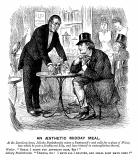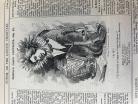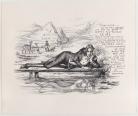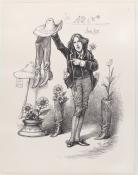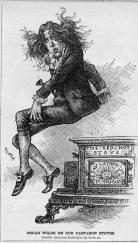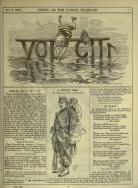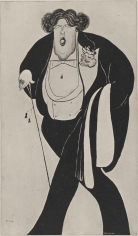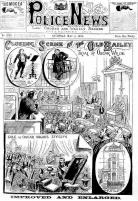Oscar Wilde as "Pansy" in Cartoons & Caricatures from 1880-1895
Created by Michael Indovina on Tue, 05/07/2024 - 17:26
This timeline is comprised of depcitions of Oscar Wilde in magazines such as Punch, Puck, Harper's Bazar, The Wasp, The Judge, Harper's Weekly, and The Illustrated Police News. The aim of this timeline is to present research surrounding the relationship between Oscar Wilde and flowers, as depicted in the aforementioned media of the time. The reason this is of interest is because of the history of the "pansy" stereotype in regards to gay men. The flower imagery at hand in these illustrations and texts---developing from sunflowers and lilies to lilacs to green carnations---allows us to fully understand Wilde's history with flowers, and what that may have meant when it came to the formation of the "pansy" stereotype.
Timeline
Chronological table
| Date | Event | Created by | Associated Places | |
|---|---|---|---|---|
| 14 Feb 1880 |
Punch Magazine: "Nincompoopiana---The Mutual Admiration Society."The earliest cartoons that get close to referencing Wilde are cartoons criticizing Aestheticism. This is one of the earliest examples. The title of this cartoon, "Nincompoopiana---The Mutual Admiration Society," is a clear poke at the validity of Aestheticism: "Nincompoopiana" seems to refer to some level of nonsensical behavior, and the "Mutual Admiration Society" appears to be making fun of Aestheticists' ideas of beauty: this cartoon views Aestheticism as mostly skin-deep, and full of too much admiring of surfaces, if you will. The dialogue occurring underneath the title of the cartoon is between Our Gallant Colonel "(who is not a Member [of the Mutual Admiration Society] thereof)" and Mrs. Cimabue Brown "...who is)." They're talking about a (fictional) poet named Jellaby Postlethwaite, who seems to express all the qualities of a stereotypical gay male æsthete. At the end of the dialogue, Mrs. Cimabue Brown says the following: "Oh, look at [Jellaby's] Grand Head and Poetic Face, with those Flowerlike Eyes, and that Exquisite Sad Smile! Look at his Slender Willowy Frame, as yielding and fragile as a Woman's!" This description of Jellaby could very well also apply to Oscar Wilde, especially with terms such as "Flowerlike Eyes" and "Slender Willowy Frame, as yielding and fragile as a Woman's!" Attributing æsthete men to flowers is a pattern that repeats throughout the timeline, whether literally (think 1882-1883) or metaphorically (think of the signs of homosexuality that Wilde exhibited from 1890-1895).
Sources: Du Maurier, George Louis. "Nincompoopiana---The Mutual Admiration Society." Punch Magazine, 14 Feb. 1880, p. 66. Du Maurier, George Louis. "Nincompoopiana." Harvard Museum, https://harvardartmuseums.org/collections/object/298491. |
Michael Indovina | ||
| 17 Jul 1880 |
Punch Magazine: "An Æsthetic Midday Meal"It is important to understand this cartoon in the context of the previous entry, "Nincompoopiana---The Mutual Admiration Society," because it features a recurring character: Jellaby Postlethwaite. In this cartoon, Jellaby is sitting at a Pastrycook's by himself, and orders a cup of water to put his "freshly-cut Lily" in. The waiter asks if he wants anything else. Jellaby replies with "Thanks, no! I have all I require, and shall soon have done!" This cartoon further pokes fun of Jellaby as this male æsthete who is obsessed with the beauty of nature, and the beauty of surfaces. This, along with his physical characteristics (mentioned in "Nincompoopiana"), feminizes and queers him compared to societal standards of masculinity during the time. Again, the Wilde parallel appears: a man obsessed with nature, but specifically flowers, this stereotypically frilly and "female" thing. The lily is one of the flowers that is repeatedly shown throughout the Oscar Wilde caricatures of 1882-1883, along with sunflowers, making both flowers symbols of aestheticism.
Source: Du Maurier, George Louis. "An Æsthetic Midday Meal: George du Maurier Cartoons from Punch magazine." Punch, 17 Jul. 1880, https://magazine.punch.co.uk/image/I0000bUqTuRftskI. |
Michael Indovina | ||
| 25 Jun 1881 |
Punch Magazine: "O.W." (Punch's Fancy Portraits.--No. 37.)In this timeline, this is the first cartoon/caricature that specifically shows Oscar Wilde. In this installment of "Punch's Fancy Portraits," Oscar Wilde is turned into a sunflower, a symbol of the Aestheticism movement. The petals of the sunflower circle his head, and his body becomes a stem, almost like the frills that people of the 1600s in England wore. A quote from the Lays of Christy Minstrelsy appears underneath the title of the drawing, "O.W.," reading "O, I feel just as happy as a bright Sunflower!" The Lays of Christy Minstrelsy was a minstrel group, and its mention in the quote here relates Aestheticism to the extremely exaggerated and overdramatic performances of minstrel shows. Underneath everything, a four line poem reads "Æsthetes of Æsthetes! / What's in a name? / The poet is WILDE, / but his poetry's tame." Through this poem, the sunflower that is Wilde becomes tame, making the sunflower a more derogatory symbol for Aestheticism than anything positive; the public views Aestheticism as schmaltzy.
Source: Sambourne, Edward Linley. "Punch's Funny Portraits.---No. 37." Punch, 25 Jun. 1881, https://magazine.punch.co.uk/image/I0000UJ5WxmvnxB4. |
Michael Indovina | ||
| 11 Jan 1882 |
Puck Magazine: "Oscar the Apostle: Puck's 'Wilde' Dream of an Aesthetic Future for America."Sunflowers and lillies are especially abound in this elaborate and colorful Puck cartoon, drawn by Frederick Burr Opper. The repetition of these flowers (especially the sunflowers) paired with repetitive snippets of writing such as "Our Æsthetic Tramp," "Our Æsthetic Waiter," "An Æsthetic Umbrella," and "An Æsthetic Bald Head" implies that the public felt that Aestheticism was very one-note, and did not develop beyond its obsession with nature and the decadent. This oversimplification of what makes something "aesthetic" decidedly strips Aestheticism of any intelligence it has, which gives this cartoon an especially mocking tone. Pair all of this with the title "Oscar the Apostle: Puck's 'Wilde' Dream of an Aesthetic Future for America," as well as text on a separate page from the image itself that replaces all r's with w's, and an overgrandiose and wheedling tone is achieved, further mocking Aestheticism. It should also be noted at this point in the timeline that Oscar Wilde was doing a lecturing tour in the U.S. from 1882-1883, hence Puck's interest in Wilde at this time.
Sources: Opper, Frederick Burr. "Oscar the Apostle: Puck's 'Wilde' Dream of an Aesthetic Future for America." Puck Magazine, Issue No. 253, 11 Jan. 1882. "Oscar Wilde In America" Website: https://www.oscarwildeinamerica.org/features/oscar-the-apostle.html.
|
Michael Indovina | ||
| 11 Feb 1882 |
Harper's Bazar: "Mr. O'Wilde, You are not the first one that has grasped at a Shadow"In this caricature of Wilde, he is being compared to Narcissus, the figure in Greek mythology who fell in love with the image of himself in a pool of water. There is a block of text to the right of the drawn image (by Thomas Nast), which reads as such:
"Narcissus,--- As he was 'hunting' one day, he bent to quench his thirst (£ or $) from a spring as clear as crystal, and a goddess caused him to fall in love with his own shadow, which was reflected in the water. The object of his desires being unattainable, he pined away from grief and the flower named after him has ever since continued an emblem or heartles 'beauty."
The inclusion of "(£ or $)" ties Wilde's supposed Narcissus-esque greed to monetary greed. The reflection of Wilde in the water is interesting as well; it almost looks like a lion, and the sunflower with the text "Notoriety" on it reads with simply "$" in the reflection. The sunflower, being the emblem of the Aestheticist movement, is stripped of its label of "Art" and replaceed with the "Notoriety" label. His reflection is a lion because he is "lionizing," or seeking celebrity status. And paralleling the myth of Narcissus, a written quote from Echo in the background reads "He is an Æsthetic sham." The supposed "truth" of being a sham is not tempting Wilde as much as his own reflection, paralleling the myth (Echo does not attract Narcissus as much as he himself does).
Source: Nast, Thomas. "Mr. O'Wilde, You are not the first one that has grasped at a Shadow." Harper's. Bazar, 11 Feb. 1882, https://www.metmuseum.org/art/collection/search/820022. "Narcissus." World History Encyclopedia, https://www.worldhistory.org/Narcissus/. |
Michael Indovina | ||
| 31 Mar 1882 |
The Wasp: "The Modern Messiah"This cartoon of Oscar Wilde appeared in The Wasp on the eve of Wilde's third lecture in San Francisco; he is deep in his tour of America at this point. Sunflowers, once again, populate the image, and the $ sign once again is printed on the Aestheticist symbol of the sunflower; Wilde is once again being accused of only being an Aestheticist out of the desire for monetary greed. Now is a good time to delve deeper into why this timeline is so interested in flowers, particularly in the sunflower and the lily. Yes, they were both known Aestheticist symbols (as can be concluded from the amount of times they have appeared in cartoons/caricatures of Wilde), but they also can be interpreted to have a queer undertone as well. Bloom & Wild's page on "The meaning, history and symbolism of sunflowers," yellow sunflowers are said to "have a meaning of goodness, truth, and timelessness." Is the beauty and radiance of the sunflower its relationship to truth? Could this truth be a queer one? If so, it could be said that engaging with Aestheticism could be more about internal truth-seeking than surface-gleaning (as the cartoons and caricatures are suggesting). The meaning of the lily (or the calla lily, to be specific), as detailed in the Greg App's page "Symbolism And Benefits of the Calla Lily" has a sexual connotation; "Freud saw it as a symbol of sexuality, while Georgia O'Keefe painted it so provocatively that she was dubbed 'the lady of the lilies.'" In addition, "In ancient Egypt, it was a marker of fertility, while the Romans saw it as a sign of sexuality due to its phallic spike." Somehow, this flower is both vaginal and phallic, which makes it rife with sexual implications no matter the type of lily. Wilde could be using the lily as a symbol of observing and understanding one's sexuality.
Sources: Keller, G.F. "The Modern Messiah." The Wasp, 31 Mar. 1882, https://www.oscarwildeinamerica.org/features/the-modern-messiah.html.
"The meaning, history and symbolism of sunflowers." Bloom & Wild, https://www.bloomandwild.com/the-blog/meaning-and-symbolism-of-sunflowers.
Greg App links on Calla Lilies: https://greg.app/calla-lily-flowers/ https://greg.app/calla-lily-benefits/#:~:text=%F0%9F%8E%A8%20Historical%.... |
Michael Indovina | ||
| 10 Jun 1882 |
Harper's Bazar: "Wilde on US. Something to 'Live Up' To in America."This cartoon of Wilde, also made by Thomas Nast, shows him standing in front of work boots with sunflowers and lilies sprouting from them, as per usual. He points to work boots and a straw hat lettered "The Picturesque Miners in the Rocky Mountains." Coming back to the monetary greed accusations, Wilde's pockets are stuffed with bags of money. The reason for the boot imagery is due to the American interpretation of Wilde's American tour: the idea was that he would "civilize" the rugged, rural population of the U.S., giving them "something to live up to": Aestheticism. Based on the aforementioned interpretations of sunflowers and (calla) lilies, it could be that Wilde wants an American audience to evaluate the beauty of their desires and of nature, and how all desires are natural because they come from the human being (early seeds of hedonistic thinking).
Source: Nast, Thomas. "Wilde on U.S. Something to 'Live Up' to in America." Harper's Bazar, 10 Jun. 1882, p. 316, https://www.oscarwildeinamerica.org/features/something-to-live-up-to.html. |
Michael Indovina | ||
| 9 Sep 1882 |
Harper's Weekly: "Oscar Wilde on our Cast-Iron Stoves"Something of note to me in this specific caricature are the pixie/fairy-like proportions of Wilde, as well as the fact that he seems to almost float on the page like a fairy; he is not seated on the cast-iron stove, as one might expect based on his position on the page. But about his proportions: not only is he floating, but his features all seem doll-like and miniatured in some way. This hair is also lengthened and made frizzy, and his arms are posed in a very unnatural way that suggests a type of dance. And of course, the sunflower returns on Wilde's lapel, this symbol of sexual self-analysis by proxy of the beauty of nature. The flower, the floating, and the proportions make him look less human and more Tinkerbell-esque, which is very queer in tone (gay men being called "fairies" is certainly not unheard of). Source: Nast, Thomas. "Oscar Wilde on our Cast-Iron Stoves." Harper's Weekly, 9 Sept. 1882, https://emuseum.mfah.org/objects/13608/a--oscar-wilde-on-our-castiron-stoves.
|
Michael Indovina | ||
| circa. Winter 1882 to circa. Winter 1883 |
The Judge: "A Thing of Beauty Not a Joy Forever: Rise and Fall of a 'Vera' Wilde Æsthete"This caricature from The Judge is fairly cut and dry: the left shows Oscar Wilde in his element, in his "beauty," by pairing him with the recurring symbols that are the sunflowers and the lilies. He is also standing above a pile of gold to symbolize the success of his lecutring tour in the United States. The right side, however, shows him leaving America to return to England with a big scroll that reads "Vera" (referring to his botched play, Vera; or, the Nihilists). He can preach but apparently he could not practice effectively. The title, "A Thing of Beauty Not a Joy Forever," is a reference to the John Keats epic poem Endymion, and "A thing of beauty is a joy for ever" is its starting line. This inversion is a commentary on Aestheticism's perceived staying power: "Not a Joy Forever," according to popular consensus. Introspection on sexuality (based on the aforementioned) flower symbols is taught but not valued, as can be interpreted by Wilde's failed play. Source: "A Thing of Beauty Not a Joy Forever: Rise and Fall of a 'Vera' Wilde Æsthete." The Judge, 1882-1883, https://www.oscarwildeinamerica.org/features/not-a-joy-forever.html. |
Michael Indovina | ||
| 20 Aug 1883 |
"Vera; or, The Nihilists" premieres at the Union Square Theatre in New York City, USA.This was Oscar Wilde's first play, and a relatively minor (and flawed) work in his overall breadth of work. It was set in Russia, and it was a tragedy about the life of Vera Zasulich, the Russian socialist activist. This was the play that Wilde first tried to get performed in America, and succeeded by the end of the summer in 1883. Sources: "Vera; or, The Nihilists." https://en.wikipedia.org/wiki/Vera;_or,_The_Nihilists. Weiss, Michael. "Vera and the Nihilists." The New Criterion, https://newcriterion.com/2008/04/vera-and-the-nihilists/. |
Michael Indovina | ||
| circa. Jul 1890 |
"The Picture of Dorian Gray" is first publishedThe Picture of Dorian Gray, one of Oscar Wilde's most famous works, also contains a theme of beauty (especially from a homosexual perspective). But what is not talked about as much is The Picture of Dorian Gray's relationship to flower symbolism. In "The Flowers of Dorian Gray, Part Three," on Multo (Ghost) [WordPress website], it talks about how Lilacs bookend the book. The quotes that are cited to "bookend" with lilacs are as such: "The studio was filled with the rich odour of roses, and when the light summer wind stirred amidst the trees of the garden, there came through an open door the heavy scent of the lilac, or the more delicate perfume of the pink-flowering thorn" (Wilde 43), and this quote from Lord Henry: "The park is quite lovely now. I don't think there have been such lilacs since the year I met you" (Wilde 246). These lilacs are present during times in which innocence falls for seduction. Again, Wilde is using flowers---something so stereotypically effeminate---to ponder on sexuality. One can't help but wonder where the "pansy" stereotype of gay men fits into this; was Wilde a prototype?
Sources: Wilde, Oscar. The Picture of Dorian Gray. Broadview Editions, edited by Norman Page, 1998. "The Flowers of Dorian Gray, Part Three." Multo (Ghost), https://multoghost.wordpress.com/2018/02/19/the-flowers-of-dorian-gray-part-three/. |
Michael Indovina | ||
| 19 Jul 1890 |
Punch Magazine: "Our Booking-Office."This is the nicest that Punch has been (and will ever be) to Oscar Wilde; not only is he spared from being in the cartoon, but The Picture of Dorian Gray is given a thorough, mixed but still very negative review, albeit as snarky as Punch always is. But it could have been worse for Wilde. The review states the following: "Mr. WILDE has preferred the sensuous and hyperdecorative manner of 'Mademoiselle DE MAUPIN,' and without GAUTIER'S power, has spoilt a promising conception by clumsy unideal treatment. His 'decoration' (upon which he plumes himself) is indeed 'laid on with a trowel.' The luxuriously elaborate details of his 'artistic hedonism' are too suggestive of South Kensington Museum and æsthetic Encyclopædias. A truer art would have avoided both the glittering conceits, which bedeck the body of the story, and the unsavoury suggestiveness which lurks in its spirit. Poisonous!" The "unsavory suggestiveness" mentioned here is the suggestion that in order to purge himself of his sins, Dorian must kill the soul of himself inside the painting and die in the real world, effectively "purif[ying] his soul by suicide..." Nevertheless, even in the 1890s, Wilde is still being dogged down for his use of Aestheticism, and allowing the eyes of the narrator to receive pleasure at every corner of the book. Will he ever be able to revel in the beauty of nature and the beauty of desire, and the naturalness of desire? For example, Basil's and Lord Henry's desires to be around the youthful, beautiful Dorian, because he is a marvel and very attractive to them.
Source: "Our Booking-Office." Punch Magazine, Vol. 99, 19 Jul. 1890, https://www.gutenberg.org/files/11919/11919-h/11919-h.htm. |
Michael Indovina | ||
| 9 Jul 1892 |
Punch Magazine: "A Wilde Idea. Or, More Injustice to Ireland!"This cartoon of Oscar Wilde shows him in solidier gear, standing guard as if a part of a larger military. The reasoning for this is because his French play, Salomé, had its license accepted by Sarah B. This makes Wilde dream of being a French citizen. However, what is stopping him is the fact that he would have to be a conscript in the French Army. The cartoon makes fun of both of his options: either go with the "Wilde" idea and go to France, or stay in Ireland and make them more dissappointed in him (the Saxon Licenser of Plays did not accept the licensing for Salomé). There is, however, something to be said about Wilde's desire to move to France that isn't quite being interacted with here. France was much more liberal in terms of gayness within men, and Wilde could probably be a bit more free in France than in Ireland or England. The desire for freeness within one's sexuality pops up again.
Source: Partridge, Sir John Bernard. "A Wilde Idea. Or, More Injustice to Ireland!" Punch Magazine, 9 Jul. 1892, p. 1, https://archive.org/details/punchvol102a103lemouoft/page/n373/mode/2up?view=theater. |
Michael Indovina | ||
| circa. 1894 |
Sir Henry Maximilian ('Max') Beerbohm's "Oscar Wilde" CaricatureAlthough not specifically in a satirical magazine, I decided to include this caricature of Wilde by Sir Henry Maximilian Beerbohm because of a few things that it is doing that have not been done in other cartoons/caricatures, yet are intrinsically related to what those other cartoons and caricatures do. Firstly, there's the specific way this Wilde has been caricaturized; instead of being turned into a beanpole, as he is usually turned into, Beerbohm made Wilde rotund. Based on the way in which this figure is made to be rotund, and based on the pattern of clothes and the length (and curl) of Wilde's hair in the caricature, it's safe to say that this body change has the effect of both feminizing him and making him more exaggerated and theatrical. He limp wrists with one hand (a stereotypically gay thing to do), and holds either a scarf or a jacket in the other. What is especially of note, however, it the flower on Wilde's lapel. This flower appears to be a green carnation, a flower that Wilde made famous in the 1890s. In Sarah Prager's article on JSTOR Daily, "Four Flowering Plants That Have Been Decidedly Queered," after the mention of pansies and The Pansy Craze of the early 20th century, the green carnation is mentioned. Prager states that "[t]he green carnation became a queer symbol in 1892 when Oscar Wilde instructed a handful of his friends to wear them on their lapels to the opening night of his comedy Lady Windermere’s Fan. From then on, wearing a green carnation on your lapel was a secret, subtle hint that you were a man who loved other men." This flower became even more pointedly queer than the sunflowers and lilies and lilacs from before. We have moved on from sexual self-analysis by looking at the beauty of sunflowers and lilies, and we have moved past the innocence of the lilacs: we have moved on to seeking others to join us in our sexual journey. The green carnation symbolizes, then, this movement outwards as a queer person into the world. Even though The Pansy Craze occurs after Wilde's passing, it's hard to not relate him and his personality to who would be called a "pansy." Common terms for flamboyant gay men were "daisy," "buttercup," "pansy," and "horticultural lad" as a whole. The lattermost seems to fit Wilde to a T; he sure loves his flowers. We can look at Wilde, then, as a predecessor to the "pansy": a flamboyant gay man who uses flowers to express himself, understand the world, and understand his desires and seek those out in the real world, not just in imagination. Sources: Beerbohm, Sir Henry Maximilian ('Max'). "Oscar Wilde." 1894, https://www.npg.org.uk/collections/search/portrait/mw43531/Oscar-Wilde. Prager, Sarah. "Four Flowering Plants That Have Been Decidedly Queered (The queer history of the pansy and other flowers)." JSTOR Daily, 29 Jan. 2020, https://daily.jstor.org/four-flowering-plants-decidedly-queered/. |
Michael Indovina | ||
| 14 Feb 1895 |
"The Importance of Being Earnest" is first performedThe Importance of Being Earnest was a satirical comedy in three acts by Oscar Wilde. Each protagonist in the play, Jack Worthing and Algernon Moncrieff, have to maintain aliases in order to exist without punishment, and express their love for Gwendolen Fairfax and Cecily Cardew. Using an alias---or playing someone who is not yourself---in order to live as you wish is an experience that many queer people can understand and relate to, Wilde included. It's no wonder he loved flowers so much; flowers were Wilde's tongue's alias for the truth.
Source: "The Importance of Being Earnest." Britannica, 11 Apr. 2024, https://www.britannica.com/topic/The-Importance-of-Being-Earnest. |
Michael Indovina | ||
| 4 May 1895 |
The Illustrated Police News: "Closing Scene at the Old Bailey: Trial of Oscar Wilde"This cartoon is depicting the closing portions of the final Oscar Wilde Trial, resulting in Wilde being convicted of "gross indecency" and being sentence to two years of hard labor in prison (the maximum sentence allowed for gross indecency charges). Wilde's health plummeted in prison, and he eventually passed away on November 30th, 1900, in France, at only 46 years old. When Wilde finally was not talking about flowers and started talking to people and searching for homosexual connection (this peaked when he was with Lord Alfred Douglas), he was shot down by governmental oppression. Are "pansies" allowed to talk about things other than flowers? Wilde should not have had to suppress his love for men under the metonymy of flowers. Even if the symbolism speaks the truth, it is a xerox of the truth. The scariest part about this whole trial is that it was the first time the general public had an idea of what a gay man looked like. In "Victorian Sexualities" by James Eli Adams, Adams states that "The concern with regulation of male lust thus converged with a new conception of sexual identity anticipated in the rise of aestheticism: the homosexual" (134). Continuing, he says that "Only with the trials of Oscar Wilde in 1895 was a clear image of 'the homosexual' firmly fixed in the public mind, along with a vivid association of literary and sexual 'decadence.'" If Wilde was the first image of a gay man to the general public, and he used flowers as substitutes for real confessions for men, then the seeds are placed for the "pansy" stereotype to rise in the 1920s and 1930s. Flamboyance and flowers were all that many gay closeted men had. At least that's what the stereotypes say. "Closing Scene at the Old Bailey: Trial of Oscar Wilde." The Illustrated Police News, no. 1628, 4 May 1895, https://peoplesgdarchive.org/item/10866/illustrated-police-news-trial-of-oscar-wilde. Adams, James Eli. "Victorian Sexualities." Victorian Literature and Culture, 1999. |
Michael Indovina |


